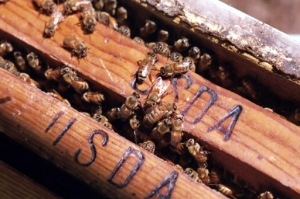Northern lights over northern Michigan (The Detroit News): Skywatchers received a celestial treat Monday and Tuesday nights when northern lights were visible in northern Michigan. A storm on the sun sent waves of solar particles 93 million miles to earth’s magnetic poles to create an aurora borealis. The light show stretched from New Hampshire to Nebraska treating citizens to red and green ribbons that shimmered against the inky sky.
Michigan rattlesnakes face uncertain future (Detroit Free Press): The U.S. Fish and Wildlife Service recommend putting the Eastern Massasauga rattlesnake, Michigan’s only venomous snake, on the threatened species list due to habitat loss and negative human interaction. While most people fear these snakes, only one or two people are bitten by the snakes each year, but there has not been a fatality for decades, according to the DNR. The best way to ensure survival of the rattlesnake is to preserve its habitat and support wetlands conservation.

Urban beekeeping is on the rise, a trend that could help bees and educate people. Image: U.S. Department of Agriculture
City bees pollinate urban education (Great Lakes Echo): Urban beekeeping is an increasingly popular teaching tool that also provides support for the threatened pollinators. Rooftops and balconies are great places for beehives in the city since the bees will fly above everyone. Programs at Michigan State University and the University of Minnesota are working to provide educational programs and events for various age groups and help support organizations that teach kids about bees. They also provide hands-on mentoring classes about basic beekeeping. They understand that no bees means no food and emphasize the importance of bees as pollinators and the food systems they support.
App shows energy sources, emails preferences to state officials (Great Lakes Echo): PicMyEnergyMix is a new web app that calculates the sources of energy used by people in Michigan and lets them adjust the mix on their screen to reflect their preferences. Users can denote how much of each energy source they would like to use. The website adjusts the other percentages proportionately. If a person favors only solar and wind power and selects exactly 50 percent of each, everything else lowers to zero. Michigan has recently lost ground when it comes to energy waste, so the PicMyEnergyMix app features a switch that people can turn on to convey that energy efficiency is their priority and email Gov. Rick Snyder and Sen. Mike Nofs their preferences and current utility mix.

